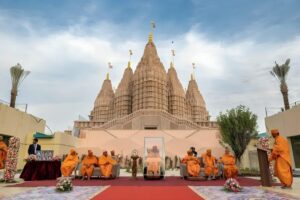Interesting facts about Ayodhya Ram Mandir


The Ayodhya Ram Mandir, scheduled to open on 22nd January 2024, is not just a temple; it represents faith, history, and remarkable architecture. Let’s explore some interesting facts that make this temple stand out.
1 – The Pure Foundation:
The temple’s construction goes beyond borders, using holy soil from 2587 regions across India. This includes places like Jhansi, Bithoori, Yamunotri, Haldighati, Chittorgarh, and the Golden Temple, symbolizing unity through pureness.
2 – Legacy of Sompuras:
The temple’s architects, the Sompura family, are known for crafting over 100 temples globally. Chandrakant Sompura and his sons, Ashish and Nikhil, have left a lasting legacy in temple architecture.


3 – No Steel and Iron Construction:
Unlike traditional methods, the Ayodhya Ram Mandir is built only with stones. This unique approach ensures the temple’s strength for a long time.
4 – Shri Ram Bricks:
The temple features bricks inscribed with ‘Shri Ram,’ reflecting ancient practices. This modern adaptation promises enhanced strength and durability.
5 – Integration of Shastras and Chaulukya Style:
Designed in the Gujara-Chaulukya style, the temple follows Vastu Shastra and Shilpa Shastra principles, blending ancient wisdom with aesthetic grace.
6 – Soil from Thailand:
Thailand sent soil for Ram Lalla’s consecration ceremony, showcasing international spiritual unity.
7 – Lord Rama’s Durbar:
Spanning 2.7 acres, the temple has three floors. The ground floor details Lord Ram’s life, while the first floor showcases Lord Ram’s Darbaar, made from Bansi Paharpur, a pink sandstone.


8 – Numbers Unveiled:
The temple, 360 feet in length and 235 feet in width, is a magnificent structure with a total height of 161 feet, including three floors and 12 gates.
9 – Contribution of Holy River Waters:
The consecration ceremony featured holy water from 150 Indian rivers, symbolizing spiritual unity and the diversity of India’s sacred waters.
10 – Monetary Donations and High-Profile Support:
The temple received substantial financial support from figures like Chief Minister Adityanath Yogi and spiritual leader Morari Bapu.
11 – A Time Capsule for Posterity:
A buried time capsule preserves information about the temple, Lord Ram, and Ayodhya for future generations.
12 – Unresolved Survey on Mythological Temple:
Archaeological surveys suggest mystery regarding the historical narrative of the site.
13 – Exquisite Pillars and Nagar Style Design:
The temple’s design includes 360 pillars in the Nagar style, making it a masterpiece of architectural finesse.
14 – Additional Funds for Revamping Temple Town:
The temple’s construction also involves revamping the surrounding town.


15 – Vision for the Future:
With 90% completion, the Ayodhya Ram Mandir serves as a testament to the past and guides future aspirations.
16 – Eco-friendly Construction:
The temple prioritizes sustainability through locally-sourced materials and energy-efficient design.
17 – Unique Carvings:
Intricate carvings narrating Ramayana episodes and Lord Ram’s life add an artistic dimension to the temple.
18 – Secular Participation:
Constructed with diverse religious participation, the temple promotes unity and secularism.
19 – Digital Documentation:
Advanced digital techniques preserve the construction process for future generations.
20 – Cultural and Educational Center:
Beyond a religious site, the temple is being developed as a cultural and educational center, showcasing artifacts related to Lord Ram and the Ramayana.
In conclusion, the Ayodhya Ram Mandir symbolizes India’s rich spiritual heritage, seamlessly blending tradition with modernity, inviting everyone to witness the confluence of faith, history, and architectural excellence.








